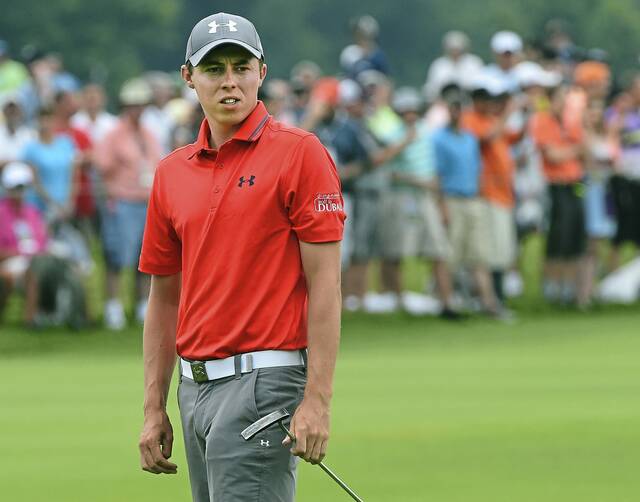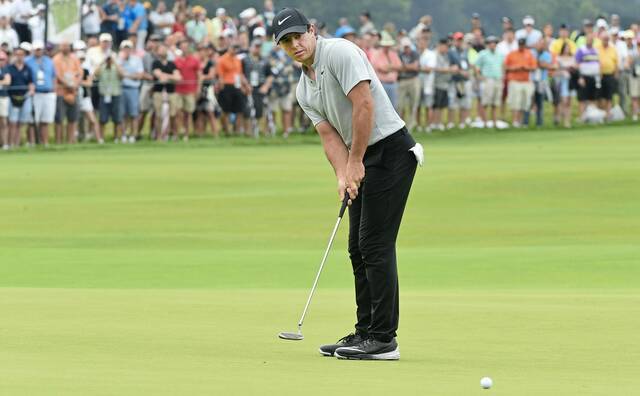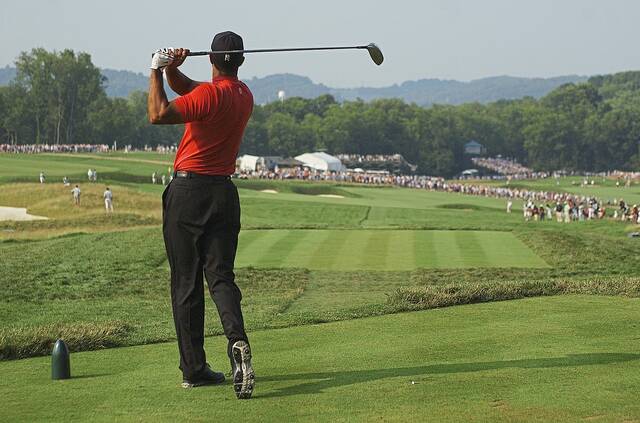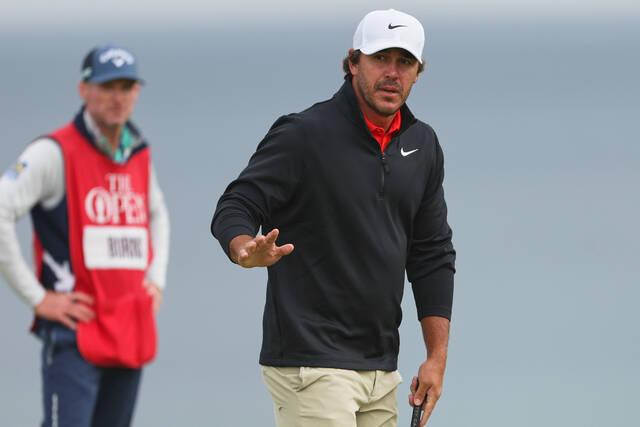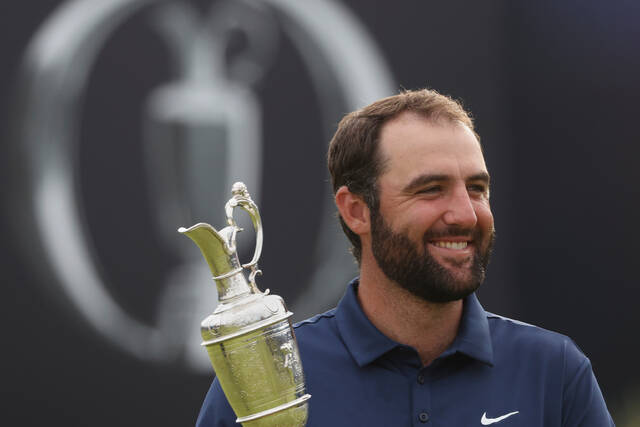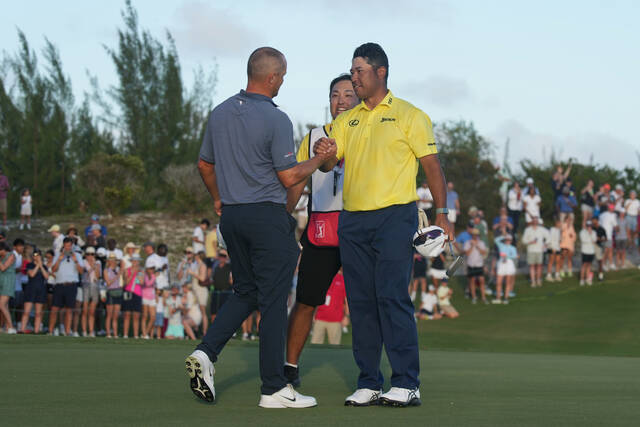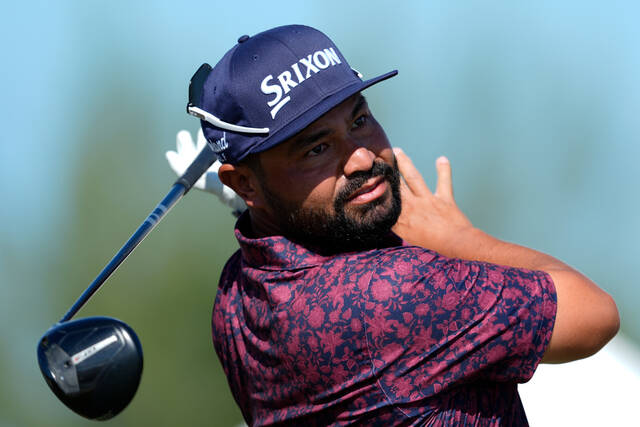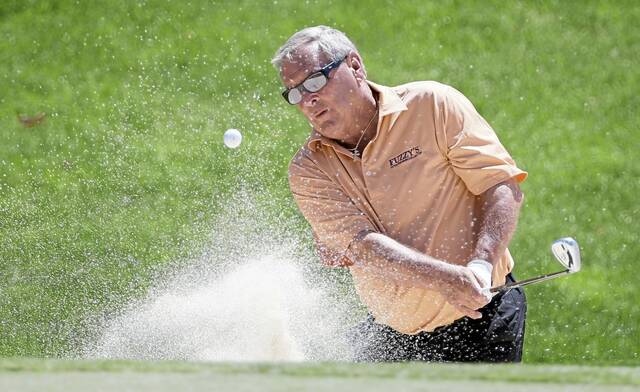From the pristine fairways and lightning-fast greens to the punishing bunkers and club-twisting rough, Oakmont Country Club is one of the toughest tests for even the world’s best golfers, who will descend upon Western Pennsylvania for the 125th U.S. Open from June 12-15.
TribLive is producing a hole-by-hole look at what makes Oakmont Country Club one of the most popular and anticipated stops for the USGA.
Hole 8 breakdown
Length: 289 yards, Par 3
Handicap: 8
2016 U.S. Open stroke average: 3.30
Description
Your eyes are not failing you, and those numbers above are not a typo. The eighth hole at Oakmont is a par 3 that approaches 300 yards. And, according to USGA officials, it will play over 300 yards during the upcoming U.S. Open.
One of the longest par 3s in the world, No. 8 features a green built for a draw off the tee, and many players will be hitting some form of wood or hybrid. Others may try to play a low-iron and run the ball onto the green if the grass is firm and dry.
Distance is not the only impediment with this hole, as the 100-yard long Sahara bunker sits along the left side of the green and crosses into the fairway. There is no longer sand behind the hole, but between 5-6 inches of rough could make for a tough pitch and putt.
During Johnny Miller’s unmatched 63 in 1973, this was the lone hole he bogeyed when he three-putted.
No. 8 played as the longest par 3 in U.S. Open history at 300 yards in 2007 and was at 299 yards in 2016.
“I promise you we’ll play it at 301 this year,” said John Bodenhamer, USGA chief championships officer.
There were 24 birdies on the eighth hole in the 2016 U.S. Open, as well as 132 bogeys and 12 double bogeys.
Memorable moment
While it wasn’t in the U.S. Open, Gil Morgan carded a hole-in-one on No. 8, which played just 245 yards during the 1978 PGA Championship at Oakmont Country Club. At the time it was the longest ace in major championship history. That was surpassed earlier this month when Si Woo Kim had a hole-in-one at the 252-yard No. 6 at the PGA Championship at Quail Hollow.
How the locals play it
Robert Rohanna, a Waynesburg Central grad, played collegiately at Penn State, where he won three tournaments and averaged 73.32 over 99 career rounds. He later played on the PGA Tour Latinoamerica (now the PGA Tour Americas). Rohanna has played Oakmont Country Club on numerous occasions, and in the 2009 Pennsylvania Open, playing as an amateur, he shot 66 in the second round. He won the Pa. Open the next year at Applebrook and won again in 2016 at Nevillewood.
“… However long it is, 60 yards short of the green is just a fairway that runs right to the green. I’ve played a lot of 235-yard holes that have nowhere to land it and this little green. But No. 8 is one of those really tough but fair holes because … you just have to hit it in that fairway, and it will run right toward the hole. It might not be the biggest birdie hole in the world, but it’s par-able.”
Around the U.S. Open
Spotlight
Hideki Matsuyama
The 2021 Masters champion, Hideki Matsuyama is seventh in the Official World Golf Ranking and a contender for the upcoming U.S. Open.
Matsuyama has 20 worldwide wins, including 11 on the PGA Tour. He is the most successful Japanese player in PGA Tour history.
He turned pro in 2013 and was ranked second in 2017 after he was the U.S. Open runner-up at Erin Hills.
Matsuyama also finished sixth in the 2024 U.S. Open at Pinehurst after shooting 2-under-par. He played in the 2016 U.S. Open at Oakmont but shot 12-over in the first two rounds and missed the cut.
He has represented the International Team in the 2013, ’15, ’17, ’19, ’22 and ’24 Presidents Cups, in addition to being an Olympic bronze medalist.
During his lengthy career, he has posted 10 top-10 finishes at major championships.
By the numbers
10: Years of exemption into the U.S. Open for the winner
19: Age of the youngest winner of the U.S. Open, John McDermott, who won in 1911
45: Age of the oldest winner of the U.S. Open, Hale Irwin, who won in 1990 after also winning in 1974 and ’79.
Quotable
“It just means more (to win at Oakmont). You just stand on the first tee at certain places in the game and you just know, you just feel it that a U.S. Open is meant to be played there. Oakmont is one of those places.”
— John Bodenhamer, USGA chief championships officer
U.S. Open history
Here’s a look at the longest par 3s in U.S. Open history:
300 yards — No. 8, Oakmont Country Club, fourth round, 2007
299 yards — No. 8, Oakmont Country Club, fourth round, 2016
299 yards — No. 7, The Los Angeles (Calif.) Country Club (North Course), second round, 2023
297 yards — No. 11, The Los Angeles (Calif.) Country Club (North Course), second round, 2023
295 yards — No. 11, The Los Angeles (Calif.) Country Club (North Course), fourth round, 2023
281 yards — No. 8, Oakmont Country Club, second round, 2007
281 yards — No. 8, Oakmont Country Club, second round, 2016
279 yards — No. 8, Oakmont Country Club, third round, 2007
277 yards — No. 7, The Los Angeles (Calif.) Country Club (North Course), third round, 2023
273 yards — No. 11, The Los Angeles (Calif.) Country Club (North Course), third round, 2023
272 yards — No. 7, The Los Angeles (Calif.) Country Club (North Course), fourth round, 2023
266 yards — No. 3, Merion Golf Club (East Course), Ardmore, Pa., fourth round, 2013
264 yards — No. 2, Shinnecock Hills Golf Club, Southampton, N.Y., fourth round, 2018
If you missed it
No. 1: U.S. Open hole by hole: No. 1 at Oakmont among world’s toughest opening tests
No. 2: U.S. Open hole by hole: Sloping green among challenges on No. 2 at Oakmont
No. 3: U.S. Open hole by hole: Church Pews a landmark hazard on No. 3 at Oakmont Country Club
No. 4: U.S. Open hole by hole: Birdie opportunity within reach on No. 4 at Oakmont
No. 5: U.S. Open hole by hole: Aggressive play can be rewarded on No. 5 at Oakmont
No. 6: U.S. Open hole by hole: Danger lurks on, around No. 6 green at Oakmont
No. 7: U.S. Open hole by hole: Players will face mental test with club selection on No. 7 at Oakmont



